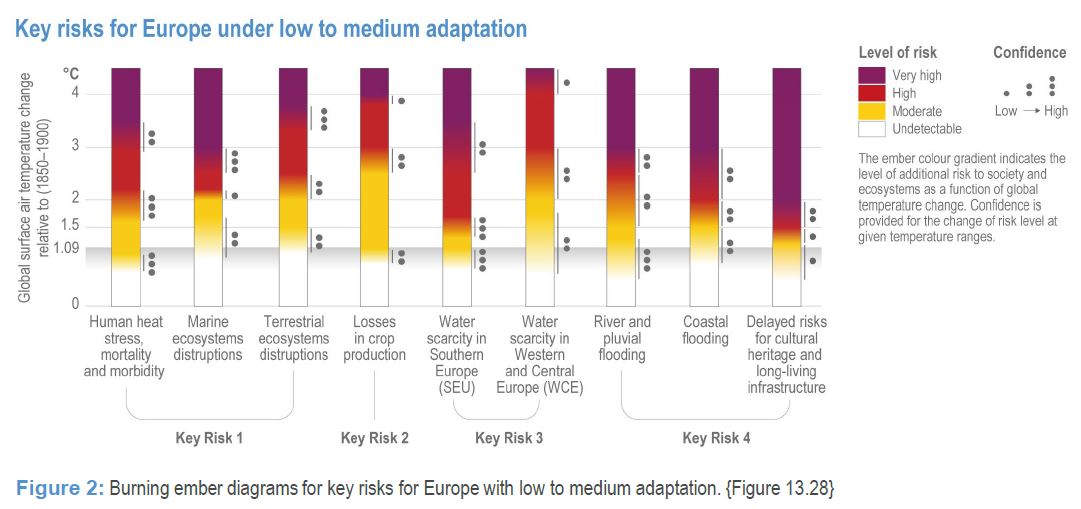IPCC: The impacts of climate change on Europe

The IPCC report (AR6 WG2) released on February 2022 has unveiled a series of in-depth analyses focusing on regional scales, delving into the quantification of climate change impacts on societies and ecosystems, assessing vulnerabilities and adaptative capacities. The fact sheet dedicated to Europe focuses on the risks the continent faces with the surge in global temperatures. In particular, four fundamental risks have been identified: heat, agricultural damage, water scarcity, and riverine and coastal flooding.
Key risk n. 1: Mortality and ecosystem change due to heatwaves
With a projected global warming of 3°C (which just a year ago was considered the most likely end-of-century scenario given the insufficient commitments of States), the number of fatalities and individuals at risk of heat stress will double or triple compared to a 1.5°C scenario. Beyond 3°C, limitations to people’s and sanitary systems’ adaptative capacities are met. High temperatures will reduce the habitats of both terrestrial and marine ecosystems, irreversibly altering their composition. This alteration will escalate with each tenth of degree above 2°C. Areas prone to wildfires are likely to expand in Europe, threatening both biodiversity and natural carbon sinks.
Key risk n. 2: Agricultural stress due to heatwaves and drought
Significant agricultural production losses are anticipated across much of Europe throughout the 21st century, with no compensatory increases projected in Northern Europe. Although irrigation stands as an effective adaptation option for agriculture, its implementation will increasingly be constrained by limited water availability, especially above 3°C.
Key risk n. 3: Water scarcity
In Southern Europe, more than a third of the population will experience water scarcity at 2°C of global warming. With 3°C, this risk would double, potentially resulting in significant economic losses in sectors reliant on water and energy. Central and Southern Europe, as well as many cities, would be particularly exposed to the risk of water scarcity at 3°C.
Key risk n. 4: Flooding and sea level rise
Exceeding 3°C would result in doubled costs and people impacted by heavy rainfall and river floodings. Coastal flood damage is expected to increase tenfold by the end of the 21st century. With current mitigation and adaptation measures, these impact will rise even more and occur sooner. Sea level rise poses an existential threat to coastal communities and their cultural heritage, especially after 2100.

Grafico dei cosiddetti "burning embers" riferiti all'Europa. IPCC AR6 WG2, 2022
Adaptation options and obstacles
Several adaptation options are available to address the risks that global warming poses to Europe.
As for the first risk (heat) behavioural adjustments are required, as well as sustainable cooling systems, urban planning, and the expansion and connection of ecosystem protected areas.
As for the second risk, which mainly impacts agriculture, irrigation will be necessary, along with vegetation cover, changes in agricultural practices, changes in the selection of animal and plant species, forest management, and wildfire prevention.
Regarding the third risk (water scarcity), it is necessary to increase the efficiency of water systems, enhance water storage and recycling, establish early warning systems, and pay attention to land use.
Regarding the fourth risk (flooding), it is necessary to implement early warning systems, create water flow spaces, and better manage land use.
Nature-Based Solutions that protect against both floods and heat are themselves threatened by high temperatures, heatwaves, droughts and sea level rise.
The main obstacles to adaptation are limited resources, lack of citizen and private sector involvement, inadequate mobilization of finances, lack of political leadership, and a weak sense of urgency. Most adaptation options depend on limited water and soil sources, thus competing and requiring trade-offs with mitigation and economic development policies measures.
In many parts of Europe, existing or planned adaptation measures are insufficient to avoid residual risk, a concept introduced by the IPCC indicating that correctly implemented adaptation measures may not be able to eliminate risk entirely. Residual risk can result in loss of habitats and ecosystem services, heat-related deaths, lost crops, water rationing during droughts in Southern Europe, and soil degradation.
To implement the necessary adaptation measures, long-term planning is required. Such measures will need to be inclusive, fair, and just, and should be tailored to meet the needs of local contexts.
This article was translated into English by Sofia Belardinelli. The original version of this article is available here.
ALSO READ:
- IPCC: Nearly direct correlation between emissions and global warming
- IPCC: Impacts of climate change are not equal for everyone
- IPCC: The impacts of climate change on Africa
- IPCC: The impacts of climate change on Europe
- IPCC: The impact of climate change on small islands
- IPCC: The impacts of climate change on Asia
- IPCC: The impacts of climate change on Oceania
- IPCC: The impacts of climate change on Central and South America
- IPCC: The impacts of climate change on North America
- IPCC: The impacts of climate change on human settlements
- IPCC Synthesis Report: every fraction of a degree matters









